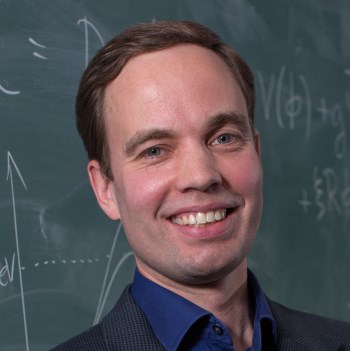Links to external sources may no longer work as intended. The content may not represent the latest thinking in this area or the Society’s current position on the topic.
Higgs cosmology
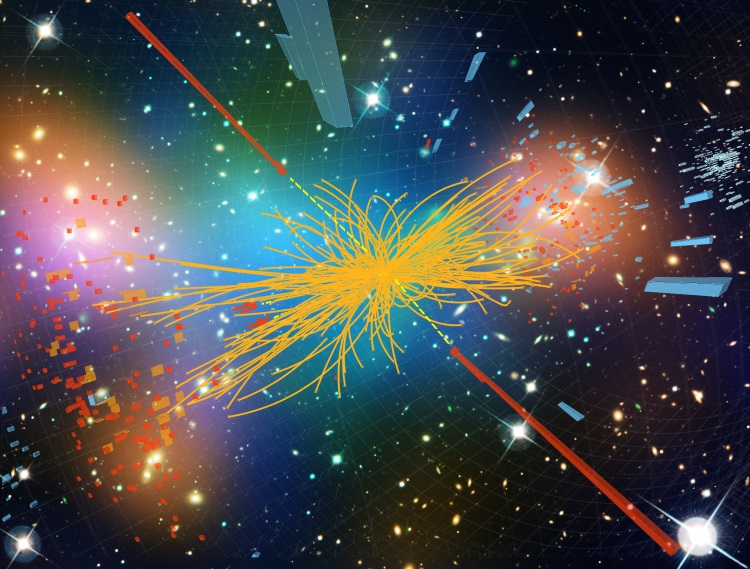
Theo Murphy scientific meeting organised by Professor Arttu Rajantie, Professor Malcolm Fairbairn, Dr Tommi Markkanen and Dr Astrid Eichhorn
What can the discovery of the Higgs boson tell us about the early universe? This meeting will explore its implications for the theory of cosmological inflation, matter-antimatter asymmetry, dark matter and other open questions in cosmology.
The biographies and abstracts of the speakers and organisers are listed below. Meeting papers will be published in a future version of Philosophical Transactions A.
Attending this event
This meeting has taken place.
Recorded audio of the talks are available below.
Enquiries: Contact the Scientific Programmes team
Organisers
Schedule
Chair
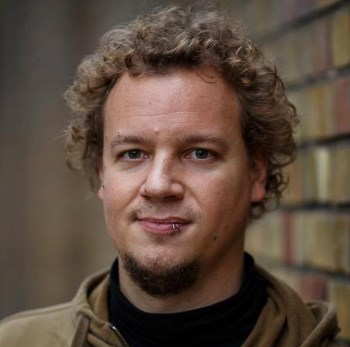
Dr Daniel G. Figueroa, CERN, Switzerland

Dr Daniel G. Figueroa, CERN, Switzerland
Daniel G. Figueroa has been a fellow at the CERN Theory Division since January 2015. During September to December 2014 he was a visiting researcher at Columbia University in New York. Between October 2012 and December 2014 he held a postdoctoral assistant position at Geneva University in Professor Ruth Durrer’s group. Previous to that he held a postdoctoral assistant position at the University of Helsinki in Professor Kari Enqvist’s group from October 2010 to September 2012. Daniel obtained his PhD in July 2010 at the Instituto de Fisica Teorica (IFT) in Madrid, with a Thesis entitled ‘Aspects of Reheating’. Throughout his PhD Daniel was also a ‘MARIE CURIE EST’ fellow at CERN (May–July 2010), during which time he travelled widely, visiting CITA in Toronto from August to December 2007; Geneva University from August to December 2008; and CALTECH in Pasadena, California, from August to December 2009.
| 09:10 - 09:40 |
Cosmological implications of Higgs near-criticality
The Standard Model electroweak vacuum lies very close to the boundary between stability and metastability, with the last option being the most likely. Espinosa will discuss several cosmological implications of this so-called ‘near-criticality’. In the metastable vacuum case, Espinosa will describe the main challenges that the survival of the electroweak vacuum faces during the evolution of the Universe. In the stable vacuum case, Espinosa will critically examine the possibility of implementing Higgs inflation. 
Professor José R Espinosa, ICREA/IFAE Barcelona Spain

Professor José R Espinosa, ICREA/IFAE Barcelona SpainJose R. Espinosa obtained his PhD (Universidad Autónoma de Madrid, Spain, in 1994), working on Particle Physics beyond the Standard Model at IEM (CSIC, Madrid). After postdoctoral positions as a von Humboldt fellow at DESY (Hamburg, Germany), at University of Pennsylvania (Philadelphia, USA) and at CERN (Geneva, Switzerland), he joined IMAFF (CSIC, Madrid) in 1999 and then IFT-UAM/CSIC (Madrid) with a permanent position. In November 2008 Jose joined ICREA as Research Professor to work at IFAE in Barcelona, Spain. |
|
|---|---|---|
| 09:55 - 10:25 |
LHC: the energy and precision frontiers
This talk will review the latest results from the LHC. Results will cover two main areas. At the energy frontier, the LHC can search for increasingly high mass Beyond Standard Model particles, some of which are dark matter candidates. At the precision frontier, the LHC is gathering ever-larger samples of Standard Model particles. This enables sensitive searches for deviations from Standard Model predictions in order to search for clues to Beyond Standard Model physics. 
Dr Sinead Farrington, University of Warwick, UK

Dr Sinead Farrington, University of Warwick, UKDr Sinead Farrington is a Particle Physicist at the LHC. She worked on the recent observation of the Higgs decaying to pairs of tau leptons and since then has made measurements of the properties of the 125 GeV Higgs boson. She is also searching for further Beyond Standard Model Higgs bosons. She is based at the University of Warwick, where she set up and leads the ATLAS group. |
|
| 11:10 - 11:40 |
Towards fundamental physics from the cosmic microwave background
Surveys of the cosmic microwave background (CMB) carry immense promise for measurements of new physics beyond the Standard Models of cosmology and particle physics. Here, Peiris will present an overview of current cosmological constraints from the CMB, and survey the capabilities of upcoming experiments, taking account of Galactic foregrounds and the effect of lensing by intervening large-scale structure. Peiris will present some recent results that highlight the science enabled by combining CMB data with large galaxy surveys. Peiris will comment on some of the experimental and methodological innovations that are needed to realise the promise of upcoming surveys. 
Professor Hiranya Peiris, University College London, UK

Professor Hiranya Peiris, University College London, UKHiranya Peiris studied at Cambridge University and got her PhD from Princeton University in 2003. She was a Hubble Fellow at the University of Chicago from 2004 to 2007. She then moved back to Cambridge as a STFC Halliday Fellow, and began a faulty position at UCL in 2009, where she is now Professor of Astrophysics. She will be the Director of the Oskar Klein Centre in Stockholm from 2016. Her research aims to test fundamental physics using large cosmological datasets, including the cosmic microwave background and galaxy surveys, using an interdisciplinary approach combining observations, theoretical physics, and advanced statistical methods. |
|
| 11:55 - 12:25 |
Fate of the spectator Higgs during and after inflation
Enqvist discusses the fluctuations of the Higgs field during inflation, the displacement of the mean Higgs field away from the origin, and its subsequent decay. Enqvist will also discuss the Higgs field fluctuations during the preheating period, pointing out that resonant behaviour can induce large fluctuations which may destabilize the electroweak vacuum. Such considerations provide an upper bound on quartic and trilinear interactions between the Higgs and the inflation. 
Professor Kari Enqvist, University of Helsinki, Finland

Professor Kari Enqvist, University of Helsinki, FinlandProfessor Kari Enqvist received his PhD at the University of Helsinki in 1983. He then worked as a postdoc at CERN and University of Wisconsin, and as an assistant professor at Nordita, Copenhagen, before returning to the University of Helsinki. Enqvist’s background is in theoretical particle physics and he has worked on grand uninfied theories, supersymmetry and neutrino physics before moving to cosmology. Kari’s main interest is the nature and origin of the primordial perturbation. |
Chair
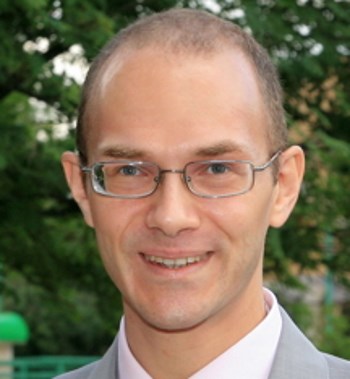
Dr Fedor Bezrukov, The University of Manchester, UK

Dr Fedor Bezrukov, The University of Manchester, UK
Fedor Bezrukov graduated from Moscow State University, and obtained his PhD in Theoretical Physics in 2003 from the Institute of Nuclear Physics of RAS, Moscow, Russia. He continued his research in EPFL, Lausanne, Switzerland (2005–2008); MPI-K, Heidelberg, Germany (2008–2010); and LMU, Munich, Germany (2010–2011). In 2012 he was Assistant Professor at the University of Connecticut, USA. In 2014 he spent a year in CERN. At the start of 2016 he moved to The University of Manchester, UK. His main research interests lie in the area of particle cosmology, with the aim to find relations between extreme fundamental energy scales, including in particular Higgs boson physics, inflation and dark matter.
| 13:40 - 14:10 |
Higgs inflation and its observational signatures
The possibility that the hypothetical inflaton field be the Higgs of the Standard Model is an extremely economical scenario. Garcia-Bellido will discuss the present cosmological constraints that can be placed on the parameters of the model, and the future observational signatures that may arise from such a scenario. 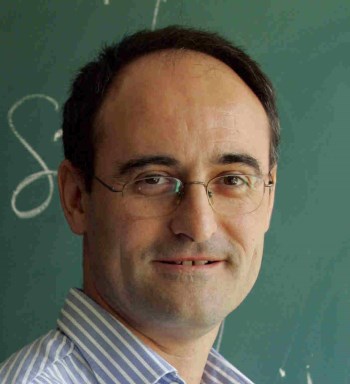
Professor Juan Garcia-Bellido, Universidad Autonoma de Madrid, Spain

Professor Juan Garcia-Bellido, Universidad Autonoma de Madrid, SpainJuan Garcia-Bellido is a Professor of Theoretical Physics at the Autonomous University of Madrid and researcher at the Institute of Theoretical Physics of the CSIC. He is the author of more than a 150 articles in specialized magazines and is a renowned theoretical cosmologist. Garcia-Bellido has worked at CERN, Imperial College London and Stanford University. His research covers a wide range of phenomena, from the origin of the universe in terms of the theory of cosmological inflation, to the formation of galaxies and the nature of dark matter and dark energy. He loves music and painting. He is married and has two children. |
|
|---|---|---|
| 14:25 - 14:55 |
Higgs and the universe: searching for simplicity
After the Higgs boson has been discovered, the Standard Model of particle physics became a confirmed theory, potentially valid up to the Planck scale and allowing one to trace the evolution of the universe from the inflationary stage till the present days. Shaposhnikov will overview the Higgs inflation and its relation to the possible metastability of the electroweak vacuum, as well as the Higgs field importance for baryogenesis and dark matter production. 
Professor Mikhail Shaposhnikov, École polytechnique fédérale de Lausanne, Switzerland

Professor Mikhail Shaposhnikov, École polytechnique fédérale de Lausanne, SwitzerlandMikhail Shaposhnikov studied at Moscow State University and got his PhD from the Institute for Nuclear Research of Russian Academy of Sciences (INR RAS) in 1982. From 1982 until 1991 he was a research scientist at INR RAS. During 1991 and 1998 he was a staff member at CERN, Geneva. In 1998 he moved to the University of Lausanne. Since 2003 he has been a Professor at Ecole Polytechnique Federale de Lausanne, leading the Laboratory for Particle Physics and Cosmology. He worked on the problem of baryon asymmetry of the universe, on phase transitions in gauge theories at high temperatures and their cosmological applications, on alternatives to compactification, on dark matter and cosmological constant, and on cosmological inflation. |
|
| 15:25 - 16:00 | Poster session | |
| 16:00 - 16:30 |
The Higgs as a link from particle physics to cosmology
In this talk Sanz will review some of the ideas which link the Higgs particle and the mechanism of electroweak symmetry breaking with other events in the Universe's history, including inflation and reheating. The connection among different sources of data (colliders, underground experiments, cosmological probes) will be emphasized 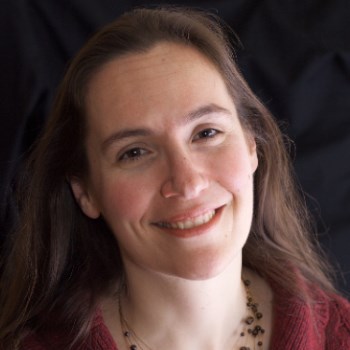
Professor Veronica Sanz, University of Sussex, UK

Professor Veronica Sanz, University of Sussex, UKBorn in Spain, Veronica Sanz held postdoctoral positions at Durham and Boston. Sanz was a visiting scholar at Harvard and got a Marie Curie at Yale. She obtained a professorship at York (Canada) in 2008, was an Associate at CERN in 2012 and moved to the UK in 2013. |
Chair
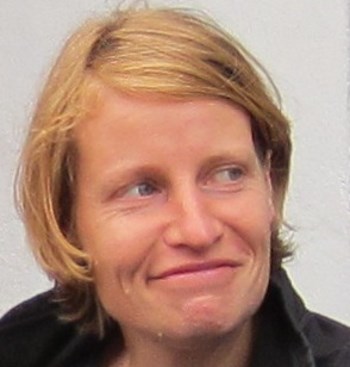
Dr Marieke Postma, Nikhef, Netherlands

Dr Marieke Postma, Nikhef, Netherlands
Dr Marieke Postma received her PhD from UCLA in 2002. After several postdoc positions, at ICTP, Nikhef, DESY and Nikhef again, she now is a permanent member of the Nikhef theory group.
Dr Postma has worked on several topics on the interface of cosmology and particle physics, ranging from dark matter, topological defects, string theory and supergravity cosmology and inflation. In recent years, a main focus of her research has been the role of the Higgs field in the early universe, and in particular whether it can play a role during inflation.
| 09:00 - 09:30 |
Vacuum stability in the Early Universe and the backreaction of classical gravity
In the case of a metastable electroweak vacuum the quantum corrected effective potential plays a crucial role in the potential instability of the Standard Model. In the Early Universe, in particular during inflation and reheating, this instability can be triggered leading to catastrophic vacuum decay. In this talk Markkanen discusses in detail how the large spacetime curvature of the Early Universe can be incorporated in the calculation and in many cases significantly modify the flat space prediction. The two key new elements are the unavoidable generation of the non-minimal coupling between the Higgs field and the scalar curvature of gravity and a curvature induced contribution to the running of the constants. For the minimal set up of the Standard Model and a decoupled inflation sector Markkanen shows how a metastable vacuum can lead to very tight bounds for the non-minimal coupling. 
Dr Tommi Markkanen, King's College London, UK

Dr Tommi Markkanen, King's College London, UKTommi Markkanen completed his PhD in theoretical physics at the University of Helsinki in 2015. His thesis focused on applying the framework of quantum field theory on a curved background to models of cosmological inflation. He has then been a visitor at Imperial College London and is currently a postdoc at King's College London. His research interests broadly lie in the area of particle cosmology, in particular electroweak vacuum stability in the early Universe. |
|
|---|---|---|
| 09:45 - 10:15 |
RG flow of the Higgs potential
Data from LHC experiments suggest that the standard model is in a near-critical regime, offering the possibility that the physical electroweak vacuum state is unstable. Gies’ group critically re-examine conventional perturbative arguments and show that the stability bound on the Higgs mass depend on the largely unknown details of the short distance physics within the standard model. The group determine new standard model stability bounds from nonperturbative RG flows as a functional of the short-distance action, relaxing conventional stability bounds. Gies shows that a metastability of the Higgs potential also has to be encoded in the short distance properties of the standard model. Studying the nonperturbative RG flow of metastable potentials gives us access to the quantum phase diagram of the model as well as to the interplay of false vacuum decay and convexity of the effective potential. 
Professor Holger Gies, Friedrich-Schiller-Universität Jena, Germany

Professor Holger Gies, Friedrich-Schiller-Universität Jena, GermanyHolger Gies’s work focuses on quantum field theory and its applications to particle physics, many-body physics and gravity. He is specifically interested in the question of how long-range properties of physical systems arise from quantum fluctuations of microscopic degrees of freedom of the underlying theory. Holger Gies is a professor of quantum theory at the University of Jena, where he is also a member of the Helmholtz Institute Jena. Previous to this, he was heading an Emmy Noether research group at the University of Heidelberg. Gies also worked as an Emmy Noether fellow at CERN. He obtained his PhD (in 1999) and his physics diploma studies at the University of Tübingen. |
|
| 11:00 - 11:30 |
Is electroweak baryogenesis dead?
Electroweak baryogenesis is an extremely testable framework. Its most popular realizations, in the MSSM and in general two Higgs doublet models, are either excluded or pushed to such a small corner of parameter space as to strain credibility. One might wonder whether it is still possible to design robust working models in light of new LHC constraints. Professor Cline will address this question, with emphasis on a model that can also provide the dark matter. 
Professor James Cline, McGill University, Canada

Professor James Cline, McGill University, CanadaJames Cline is a Professor of Physics at McGill University. After his PhD from Caltech, he held postdoctoral positions at Ohio State University, McGill, and University of Minnesota. His interests lie at the interface of particle physics and cosmology, including theories of early universe inflation, the asymmetry of matter over antimatter, and dark matter. |
|
| 11:45 - 12:15 |
Higgs condensate relaxation and the origin of matter
The recent measurement of the Higgs boson mass implies a relatively slow rise of the Standard Model Higgs potential at large scales. This allows the Higgs field to develop a large vacuum expectation value during inflation. The relaxation of the Higgs field from its large postinflationary value to the minimum of the effective potential represents an interesting new stage in the evolution of the universe. The matter-antimatter asymmetry could be generated during this epoch. 
Professor Alexander Kusenko, University of California Los Angeles, USA & Kavli IPMU, University of Tokyo, Japan

Professor Alexander Kusenko, University of California Los Angeles, USA & Kavli IPMU, University of Tokyo, JapanProfessor Kusenko grew up in the Soviet Union and obtained his undergraduate education at Moscow State University. He received his PhD degree from Stony Brook University in the USA in 1994. After that, he worked at the University of Pennsylvania (1994-1996) and at CERN (1996-1998), and joined University of California, Los Angeles in 1998. In addition to his professorial appointment at UCLA he has held positions of a RIKEN Fellow at Brookhaven National Laboratory (1999-2014) and of a Senior Scientist at Kavli IPMU, University of Tokyo (2007-present). In 2008 Professor Kusenko was elected an APS Fellow, and in 2012 he was awarded an Outstanding Referee Award by American Physical Society. He has served on the board of Aspen Center for Physics since 2004, and has recently been re-elected for a third 5-year term. |
Chair
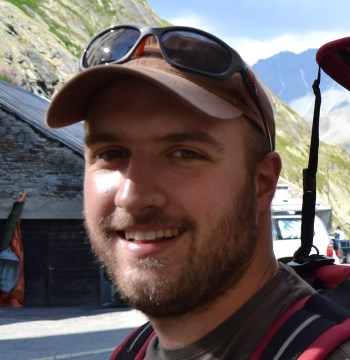
Dr Enrico Morgante, DESY, Germany

Dr Enrico Morgante, DESY, Germany
Enrico Morgante is a PhD student in Theoretical Physics at University of Geneva. In October 2016 he will start a postdoc in the DESY theory group. After completing his undergraduate studies in Scuola Normale Superiore (Pisa) in 2012, he moved to Geneva for a PhD under the supervision of Toni Riotto. His research has focused mostly on searches for dark matter particles, in particular at the LHC and with indirect probes. He is also interested in the problem of the Higgs vacuum instability and its possible relations to cosmology.
| 13:30 - 14:00 |
Higgs-portal dark matter: status and prospects
Djouadi discusses scenarios in which the particles that form the dark matter in the universe interact mainly or exclusively with Higgs bosons, either the one of the standard model of particle physics or those of its extensions. The case of scalar, fermionic and vector dark matter particles are considered. Present constraints from collider experiments like the LHC and astroparticle physics experiments that search directly or indirectly for these particles are summarised. The prospects for future studies are discussed. 
Professor Abdelhak Djouadi, Université Paris-Sud, France

Professor Abdelhak Djouadi, Université Paris-Sud, FranceAbdelhak Djouadi is a Director of Research at the French National Center of Scientific Research (CNRS), based at the Université Paris-Sud in Orsay, and a Research Associate at the European Organization for Nuclear Research (CERN) in Geneva. He is an expert of the phenomenology of the weak, electromagnetic and strong forces of elementary particles and worked on tests of the Standard Model that unifies these interactions in a unified framework and its new physics extensions at high-energy collider and dark matter experiments. In particular, he did major work on the physics of the Higgs boson which has been discovered at CERN in 2012. He was awarded several distinctions like the Silver Medal of the CNRS and the Alexander von Humboldt Prize and received an Advanced Grant of the European Research Council for the project Higgs at LHC in 2012. |
|
|---|---|---|
| 14:15 - 16:45 |
The serendipity of electroweak baryogenesis
Servant will report how the CKM matrix can be the source of CP-violation for electroweak baryogenesis if Yukawa couplings vary at the same time as the Higgs is acquiring its vacuum expectation value, offering new avenues for electroweak baryogenesis. The advantage of this approach is that it circumvents the usual bounds from electric dipole moments. These ideas apply if the mechanism explaining the flavour structure of the Standard Model is connected to electroweak symmetry breaking, as motivated for instance in Randall–Sundrum or composite Higgs models. Servant will show how this can be compatible with experimental constraints and naturally leads to the correct amount of the baryon asymmetry. 
Professor Geraldine Servant, DESY and the University of Hamburg, Germany

Professor Geraldine Servant, DESY and the University of Hamburg, GermanyGeraldine Servant got her PhD in 2001 from University Paris 11 for theoretical research conducted at CEA Saclay and McGill University in Montreal. After postdoc years at the University of Chicago she returned to CEA Saclay on a permanent position, and eventually moved to CERN's Theory group in 2006, first as a Fellow and then on a 5-year contract with an ERC Starting Grant. In 2013 she moved to Barcelona where she was appointed Research Professor at ICREA (Catalan Institution for Research and Advanced Studies). In 2015 she became DESY scientist and Professor at University of Hamburg. Her major direction of research is on the particle-cosmology interplay, in particular on the dark matter and the origin of the matter-antimatter asymmetry of the universe, with special emphasis for cosmological consequences of the electroweak phase transition in the early universe. |
|
| 15:30 - 16:00 |
Gravitational waves from a first order electroweak phase transition
The direct detection of gravitational waves by LIGO has led to heightened interest in other observable sources of gravitational waves, both astrophysical and primordial. There is also growing interest in proposed detectors such as LISA, scheduled for launch in 2034. In this talk, David will focus on one possible primordial source of gravitational waves: first order phase transitions in the early universe. The resulting gravitational wave signal is a good candidate for detection at next-generation gravitational wave detectors. An electroweak-scale first order phase transition could yield information about physics beyond the Standard Model that will otherwise remain out of reach of colliders for quite some time. David will discuss efforts to simulate and model the phase transition and the resulting production of gravitational waves. 
Dr David Weir, University of Helsinki, Finland

Dr David Weir, University of Helsinki, FinlandDavid James Weir received his doctorate from Imperial College London in 2011, before moving to the University of Helsinki as a postdoc. In 2014 he was awarded a Marie Curie Fellowship at the University of Stavanger in Norway, before moving back to Helsinki in 2016. His work is principally on very large numerical studies of the physics of the early universe, including first-order electroweak phase transitions, topological defect formation and the end of inflation. |
|
| 16:15 - 17:00 | Summary of discussions |

